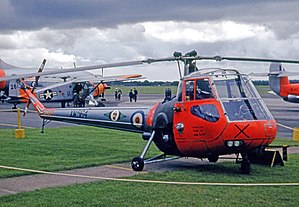Saunders-Roe Skeeter
| Skeeter | |
|---|---|
 |
|
| Skeeter AOP.12 of the Central Flying School of the Royal Air Force | |
| Role | Trainer, Scout |
| Manufacturer | Saunders-Roe |
| First flight | 8 October 1948 (Cierva W.14) |
| Introduction | October 1956 |
| Primary users |
British Army Royal Air Force German Army German Navy |
The Saunders-Roe Skeeter was a two-seat training and scout helicopter that was developed and produced by British manufacturer Saunders-Roe ("Saro") of Cowes and Southampton, in the United Kingdom.
Work on what would become the Skeeter had been commenced by the Cierva Autogiro Company as the Cierva W.14. Following Saunders-Roe's take over of Cierva, it was decided to continue its projects, including the Skeeter. Despite an initial preference for the rival Fairey Ultra-light Helicopter, which had already been ordered, there was a reversal of fortune when interest from the Bundeswehr in the potential procurement of a large number of Skeeters. This led to the British order for the Ultra-light Helicopter being cancelled and the Skeeter effectively taking its place, which also served to guarantee an export order from Germany.
During the late 1950s, the Skeeter entered service with the British Army Air Corps, the German Navy, and the German Army. It has the distinction of being the first helicopter to be used by the Army Air Corps. While some consideration had been made to developing a version of the Skeeter powered by a turbine engine instead of a piston engine, it was decided to produce the developmental Saro P.531 for this purpose instead of a more direct Skeeter derivative.
In 1947, the Cierva Autogiro Company commenced work on a new project, which was designated as the W.14 Skeeter. As designed, it was a relatively compact two-seat helicopter, intended to be suitable for use as both a civilian aircraft and for aerial observation duties with military customers. The original engine selected to power the Skeeter was a single 110 hp Jameson FF-1 air-cooled horizontally-opposed piston engine. On 10 October 1948, the first prototype Skeeter performed its maiden flight at Eastleigh airfield. Initial flight trials of the prototype proved the rotorcraft to be underpowered, which was partially as a result of the experimental Jameson engine being prone to overheating. In response, the company decided to develop an improved Mark 2 Skeeter which was to be equipped with the well-established de Havilland Gipsy Major 10, which proveded 145 hp (108 kW). The Mark 2 Skeeter was a noticeably larger aircraft and had a different appearance.
...
Wikipedia
